I touched on planning processes in my previous post about time when teaching the Language paper, but I also spend a great deal on the planning in teaching, holding it in high regard, particularly when responding to the writing questions of course. Here, I will outline how I set about teaching planning in a way that I feel encourages meaningful responses using a structure that dismisses the formulaic.
Reading: annotations are the plan
As outlined in the previous post around the Language paper, I chant,’annotating is the plan!’ The work that goes into the first ten mark question not only acts as a springboard for that question, but when responding to Paper 2, acts as a plan for further questions, helping them to form thoughts around key aspects of the text.
For paper one, I ask students to do the following:
- work out times
- ‘block off’ sections for the particular demands of the questions: lines 1-10 for Q2, 11-20 for Q3 etc. This ensures their focus is not simply wasting time reading the entire extract; I remember following my first moderation meeting as an examiner, there was hearsay in schools about 8 minutes on average wasted by students reading the text before responding to the extract; that’s not what we do on my watch.
- Then, word methodically through the one mark responses before coming to the first ten mark question.
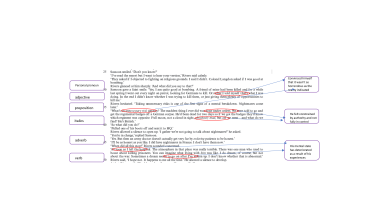
As mentioned, students plan by identifying 6-7 quotations, no more than 5 words and then identifying terminology (using ‘word’ if unsure) and down the right, outlining their three key ideas. Quotations are then allocated one of these three ideas to avoid replication and focus the idea behind the reason why the student originally decided to pick out the quotation in the first place. Words are time, so the plan takes most of the time because it ensures concision once we write. My third blog will outline writing structures.
For paper 2, the annotations can then be used as a springboard for later questions for those less confident students that see each question as a new hurdle entirely.
To take an example from one of the previous Eduqas C2 papers, the paper provides two articles: a newspaper article, `Kendrick Lamar Live: Review`, by Marcus Teague, and an extract from, ‘Mr Dickens’ Readings’, from a newspaper article, written by an anonymous journalist. The question is:
How does Marcus Teague show that Kendrick Lamar is an exciting performer? [10]
We use what, how, why as a level up process: the one mark questions are what, this question as a how, requires up to identify what, they explore how. And so, the next step is to track through the text to identify as many quotations that contribute to Lamar as exciting, before then selecting two from the beginning, middle and end of the text, identifying the terminology of the most significant word and writing on the left hand side. On the right, they then have to consider three key ideas based on what they have selected- for this example, that Kendrick Lamar is portrayed as exciting as a result of: the staging, the crowd, and the performer’s presence on the stage. Students allocate two quotations to each key idea, and this forms their plan for writing.
This process then feeds into subsequent questions, as the comparison ten mark question for this paper is:
Both of these texts are about public performances. Compare the following:
what the writers say about each performer’s talents;
how they make each performer sound impressive. [10]
We already know the key components of the performance from our initial how question, so we will compare: the depiction of the crowd, the staging, and the performer presence description itself. I ask students to use their existing ideas as a starting point to then draw up a quick table:
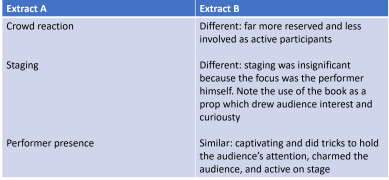
The three key ideas were our original ideas from Q2, which we can now weave as what, how statements in accordance with the requirements of the comparison question (in bold).
Writing
Using the window box plan that I referred to in my previous blog about time, we plan for all writing tasks using this pretty laughably simplistic structure, but it works. I’ve found Chris Curtis’ weekly 200 word challenge to be absolutely essential to driving change for the writing question. The ability to cope with a ‘cold’ task, write to a word count within a specific time limit, but most importantly, to ensure that the process of planning is not something crammed into the last few months of term, but repeated, deliberate practice over a sustained period of time- and well worth it, considering the marks at stake here. Non fiction lit-linked tasks have been an incredible way to introduce students to the conventions of the non-fiction texts, but also keeping abreast of their knowledge of the literature texts themselves (thank you to Jen Ludgate for he original ideas that I could then adapt to my texts). Rather than sink students into a pit of confusion (‘it said report, but not about Juliet, miss! I tanked!’), it enables students to use their knowledge to feel confident in compiling a non fiction piece. An example:
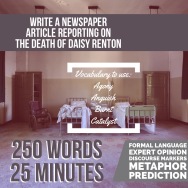
All of my literature-linked writing challenges are on my resources page, and Litdrive, of course.
To focus on non-fiction, there are two tasks on the second paper that perhaps look a little like this:
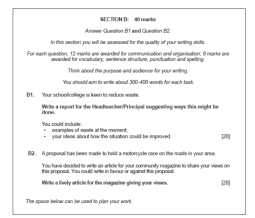
And so, we window plan. Look out for that magic three again:
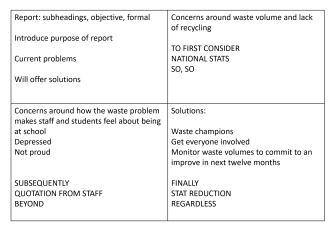
We identify form, audience and purpose in the first box, and then each section outlines the first word of the opening paragraph to consider discourse markers, a particular technique to include that ‘fits’ the form, and a sentence type that will be present in that section. This isn’t to say that other sentence variation won’t be present, but this process creates a more conscious process for writing. You will also notice there isn’t a nifty punctuation cross off thing incorporated in to the plan: I don’ do that. I tend to find that the various punctuation types are then shoe horned in, and so what I try to do is include sentence variations that make use of punctuation, as opposed to ‘use a semi colon.’ I would also argue that some of the most articulate, well-crafted pieces have been written with sporadic glimmers of extended punctuation and so for me personally, I see these attempts from students as a result of select, methodical sentence variation.
When writing in response to the fiction task, the window gets dragged out for another run, but with the mantra of ‘one, one, one’: one place, one hour, one character and their thoughts. We also plan for circular plots: our characters return to the same place, or the same line as the start, but somehow changed in themselves. Again, the strategic use of 200 word challenge lessons has seen such a success over teaching formulas and prepared plotlines for any question- for me, it just doesn’t work, or define what I set out to teach.
In my next blog, I will share how I set about teaching how to pull it altogether and write for both sections of the Language papers. Hope it’s been useful.

1 Comment